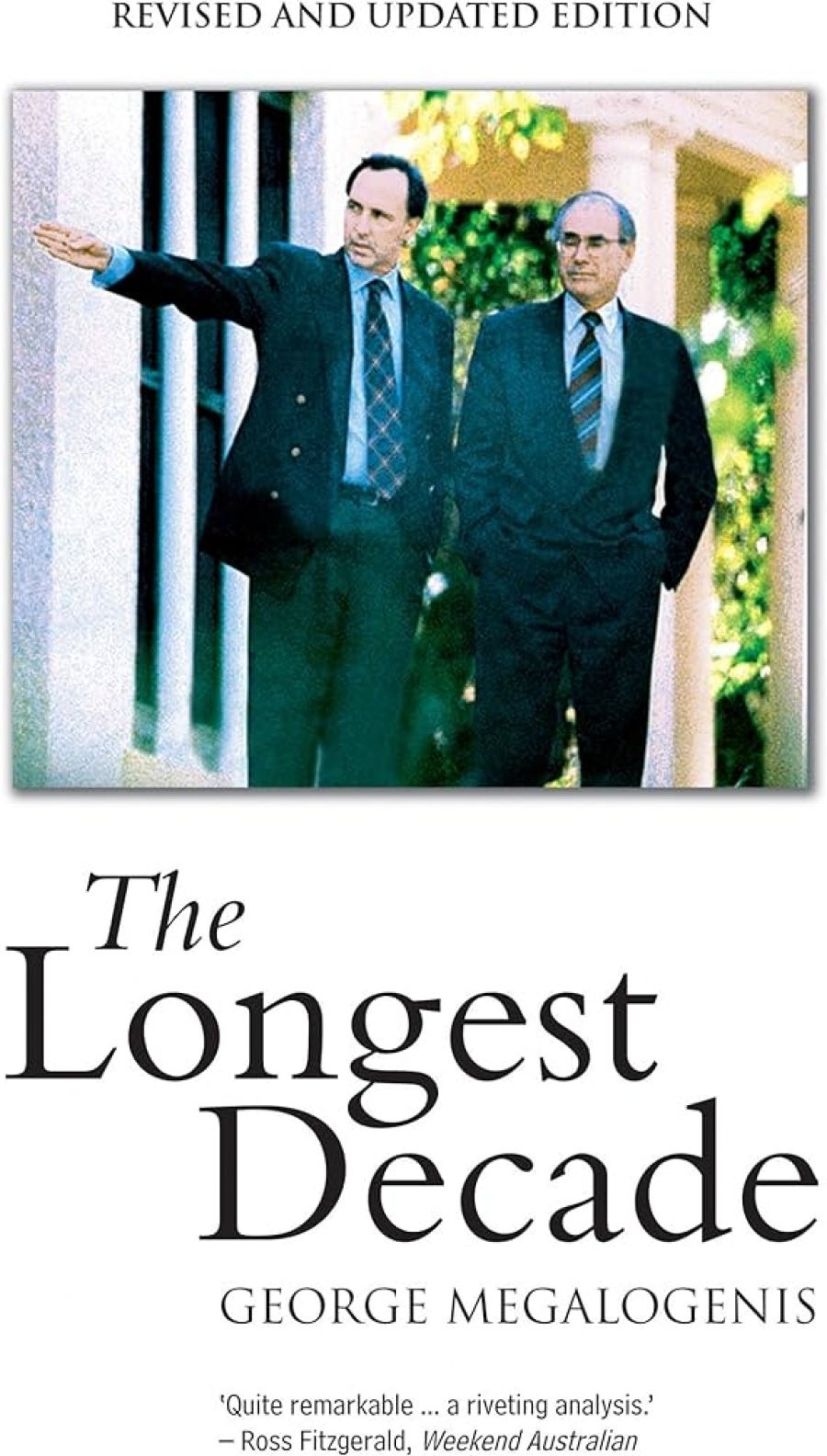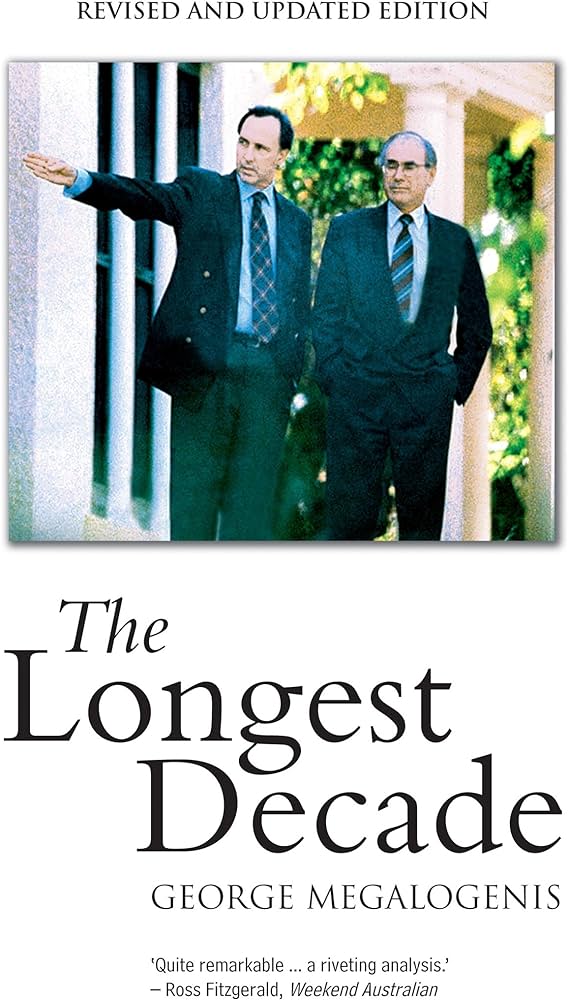
- Free Article: No
- Contents Category: Politics
- Custom Article Title: After the ball
- Review Article: Yes
- Article Title: After the ball
- Online Only: No
- Custom Highlight Text:
In a recent column in the Australian, George Megalogenis looked back to Arthur Fadden’s budget of 1952 as a possible comparison with the current financial situation. Few political scientists, let alone journalists, display this sort of historical memory. In 2006, Megalogenis published The Longest Decade, an account of the combined years of Paul Keating and Howard, based upon extensive interviews with the two leaders. The book was reviewed in ABR by Neal Blewett (November 2006), who regarded the book as a useful ‘bullshit detector’ on his newspaper colleagues, whose political journalism appeared in The Howard Factor that same year.
- Book 1 Title: The Longest Decade
- Book 1 Biblio: Scribe, $29.95 pb, 410 pp
- Book 1 Cover Small (400 x 600):

- Book 1 Cover (800 x 1200):

The Longest Decade will be replaced by books written at more remove from the period discussed, but it is worth taking seriously for two reasons. First, Megalogenis, unlike most of his colleagues at the Australian, is scrupulously non-partisan, and has a story to tell which is more complex than that of either Keating’s or Howard’s supporters. Second, Megalogenis is perhaps the most astute of contemporary journalists in reading the significance of statistics for political change.
A note of caution: I know George Megalogenis, and I have discussed some of the ideas in this book with him. In an ideal world, that might disqualify me from reviewing his book. Had he written a more personal book that might have been the case, but The Longest Decade tells us little about its author. Megalogenis joined the Canberra press gallery in 1988, and this book reflects a view shaped by the events of the past twenty years. It is not a personal account, although his own observations come through at moments, as in an early glimpse of the relationship between Gareth Evans and Cheryl Kernot.
There is a theme to The Longest Decade, which is clearer in the new edition than in its original version, and that is the move from ‘growth to greed’ during this period of boom. Megalogenis has written at length about the apparently unchallenged rise of individualism and consumerism, symbolised for him by the McMansions that ring our cities in a ‘monologue of materialism’. This is not an academic book – Blewett nicely called his style ‘more hip than mandarin’ – so he largely ignores academic writers such as Michael Pusey or Mark Peel, whose analysis would support most of his own.
The strength of Megalogenis’s analysis is to discern the underlying changes in Australia wrought by (his term) ‘women and wogs’. He is less convincing when he abandons the safety of census figures and electoral results for silly generalisations such as ‘Australians are, essentially, apolitical’. But the nerd in Megalogenis ensures he will soon return to the sort of data generated by his ‘electoral income ladder … using customised tables from the 2001 census’. The journalist in him allows him sometimes to spot the telling cultural moment, as when he invokes the reality show, The Block, which pitted four couples against each other in renovating a Bondi apartment block, to underlie the materialism that lay at the core of economic rationalism.
Future historians will return to The Longest Decade for the verbatim remarks of the two men, each of whom regarded the other as his major adversary. (One of the most revealing comments comes from Howard, who acknowledged the Labor caucus was right to get rid of Hawke in 1991 to increase their chances of re-election. One wonders whether he winces if he comes across that comment now.) The pairing of the two reminds us that Keating is only five years younger than Howard. Their stories are almost caricatures of twentieth-century Australian politics: the state-school boy with ambition, versus the Catholic school drop-out.
Keating and Howard were far closer on a number of issues than they or their supporters wished to acknowledge. There were clear and politically important differences on the republic, on reconciliation, on the treatment of refugees and on the ‘history wars’. Their personal tastes in music and literature clearly differed, though Howard rarely spoke of matters cultural in the way in which Keating would extol Mahler. But on the basic premises of economic and foreign policy, the continuity was greater than many of us like to admit. In practice, their views of the United States, China, Japan and Indonesia reflected a Canberra consensus.
The third man in Megalogenis’s account is the former Victorian premier Jeff Kennett, whose relations with the two primary actors was more complex than party allegiances would suggest. Although both Keating and Howard came from Sydney and indeed grew up within a few miles of each other, Kennett ensures that Melbourne is a strong presence in the earlier part of the book, although the psephologist in Megalogenis results in increased attention being paid to the electorally more volatile states of Queensland and New South Wales.
The Longest Decade is hastily written, overlong and badly in need of the sort of tough editing no publisher can afford any longer. It is remarkable that any working journalist can find time to write books, and for a certain sort of writer prolixity comes easier than terseness. Someone should fund sabbaticals for our best journalists to write without the distractions of the daily grind.


Comments powered by CComment